Related Research Articles

Platinum is a city in Bethel Census Area, Alaska, United States. The population was 61 at the 2010 census, up from 41 in 2000.
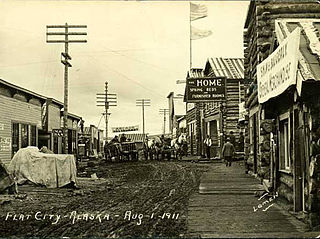
Flat is a census-designated place (CDP) in Yukon-Koyukuk Census Area, Alaska, United States. As of the 2010 Census, the population of the CDP was 0, down from 4 residents in 2000. Its post office closed in January 2004.
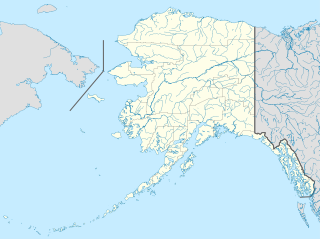
Ruby is an incorporated town in central western Alaska, situated on the south bank of the Yukon River at the northwesternmost tip of the Nowitna National Wildlife Refuge. It is accessible only by boat or air. A formerly sizeable gold-mining and lumbering town servicing the region, at the 2010 census the population was just 166, with only a general store and post office remaining as businesses, down from 188 in 2000.

A gold rush or gold fever is a discovery of gold—sometimes accompanied by other precious metals and rare-earth minerals—that brings an onrush of miners seeking their fortune. Major gold rushes took place in the 19th century in Australia, New Zealand, Brazil, South Africa, the United States, and Canada while smaller gold rushes took place elsewhere.
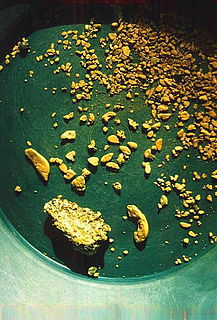
A gold nugget is a naturally occurring piece of native gold. Watercourses often concentrate nuggets and finer gold in placers. Nuggets are recovered by placer mining, but they are also found in residual deposits where the gold-bearing veins or lodes are weathered. Nuggets are also found in the tailings piles of previous mining operations, especially those left by gold mining dredges.

First Quantum Minerals Ltd. is a Canadian-based mining and metals company whose principal activities include mineral exploration, development and mining. Its main product is copper, which accounts for 80% of revenues as of 2016.
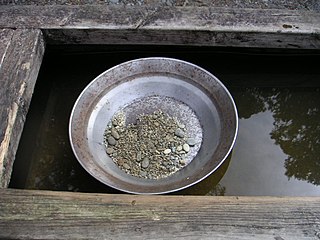
Gold prospecting is the act of searching for new gold deposits. Methods used vary with the type of deposit sought and the resources of the prospector. Although traditionally a commercial activity, in some developed countries placer gold prospecting has also become a popular outdoor recreation.

The Welcome Stranger is the biggest alluvial gold nugget found, which had a calculated refined weight of 97.14 kilograms (3,123 ozt). It measured 61 by 31 cm and was discovered by prospectors John Deason and Richard Oates on 5 February 1869 at Moliagul, Victoria, Australia, about 14.6 kilometres north-west of Dunolly.
Jamie Smith credited as James T. Smith, is an Alaskan painter, printmaker, cartoonist and creator of the comic strips "Freeze-Frame" and "Nuggets".

Ohio City is an unincorporated community and a U.S. Post Office in Gunnison County, Colorado, United States. The Ohio City Post Office has the ZIP Code 81237.

The Treadwell gold mine was on the south side of Douglas Island, .5-mile (0.80 km) east of downtown Douglas and southeast of downtown Juneau, owned and operated by John Treadwell. Composed of four sub-sites, Treadwell was in its time the largest hard rock gold mine in the world, employing over 2,000 people. Between 1881 and 1922, over 3 million troy ounces of gold were extracted. Not much remains today except for a few crumbling buildings and a "glory hole". Although John Treadwell had twelve years of experience in both placer and lode mines, he was a carpenter and builder by trade who had come to Alaska prior to the Klondike Gold Rush.
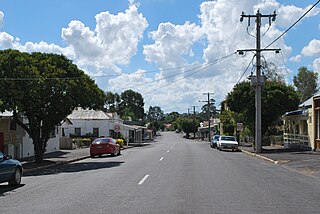
Tarnagulla is a gold mining town in central Victoria, Australia. The town is in the Shire of Loddon local government area, 183 kilometres (114 mi) north west of the state capital, Melbourne. At the 2011 census, Tarnagulla had a population of 304. By 2016, the population was 133.

Harris is a village in the Canadian province of Saskatchewan within the Rural Municipality of Harris No. 316 and Census Division No. 12. It was the site of the Great Ruby Hoax in 1914. Harris was named for Richard Elford Harris, an early settler to the area.
Gold mining in Alaska, a state of the United States, has been a major industry and impetus for exploration and settlement since a few years after the United States acquired the territory in 1867 from the Russian Empire. Russian explorers discovered placer gold in the Kenai River in 1848, but no gold was produced. Gold mining started in 1870 from placers southeast of Juneau, Alaska.

The Carolina Gold Rush, the first gold rush in the United States, followed the discovery of a large gold nugget in North Carolina in 1799, by a 12-year-old boy named Conrad Reed. He spotted the nugget while playing in Meadow Creek on his family's farm in Cabarrus County, North Carolina. Conrad took the 17 pounds (7.7 kg) gold nugget home to show his father. However, gold was not commonly seen in their community and the value of the nugget was not understood. The nugget was used as a door stop in the family's home for several years. In 1802, Conrad's father, John Reed, showed the rock to a jeweler, who recognized it as gold and offered to buy it. Reed, still unaware of the real value of his "doorstop," sold it to the jeweler for $3.50.
The Ruby–Poorman mining district in the U.S. state of Alaska produced nearly a half million ounces of gold, all from placer mines. Some of the largest gold nuggets found in Alaska are from the district, which lies along the Yukon River. The placers are mostly deeply buried, and most were originally worked with shafts and drifts. Dozens of creeks in the district were mined, many more bear gold prospects. Cassiterite, platinum, scheelite, allanite, and native bismuth have been recovered along with gold from placer mines in the district.
Mining in the United States has been active since the beginning of colonial times, but became a major industry in the 19th century with a number of new mineral discoveries causing a series of mining rushes. In 2015, the value of coal, metals, and industrial minerals mined in the United States was US $109.6 billion. 158,000 workers were directly employed by the mining industry.
Mining is an important industry in Pakistan. Pakistan has deposits of several minerals including coal, copper, gold, chromite, mineral salt, bauxite and several other minerals. There are also a variety of precious and semi-precious minerals that are also mined. These include peridot, aquamarine, topaz, ruby, emerald, rare-earth minerals bastnaesite and xenotime, sphene, tourmaline, and many varieties and types of quartz .
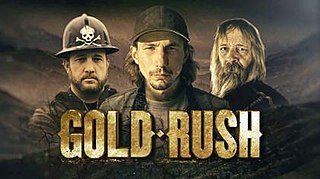
Gold Rush is a reality television series that airs on Discovery and its affiliates worldwide. The series follows the placer gold mining efforts of various family-run mining companies, mostly in the Klondike region of Dawson City, Yukon, Canada. In its 12th season as of early 2021, prior seasons also included mining efforts in South America and western North America.

Gold Rush: White Water is a reality television series that airs on the Discovery Channel. A spin-off of Gold Rush, the series follows placer gold miners "Dakota" Fred Hurt and his son Dustin Hurt, returning to McKinley Creek in Haines Borough, Alaska, seeking their fortune by suction dredge diving within its raging waters.
References
- ↑ "Defendant - Summary (3PA-11-01710MO City of Houston vs. Clay, Barry L)". CourtView. Alaska Court System. Archived from the original on April 2, 2012. Retrieved October 14, 2011.
- ↑ "Alaska Symbols". Symbols of Alaska. Fairbanks: Aurora Webmasters. Retrieved October 14, 2011.
- ↑ "Silverado discovers huge nugget". World Gold Council. Retrieved 2007-04-02.
- ↑ Steve Herschbach. "Alaska Gold Mining FAQ". Alaska Mining & Diving Supply. Archived from the original on 2006-10-18. Retrieved 2007-04-02.